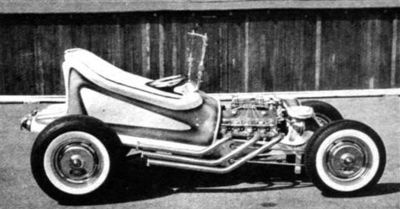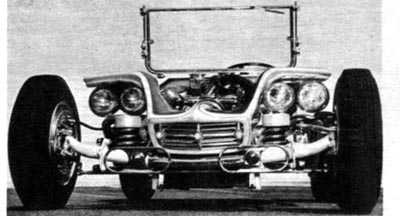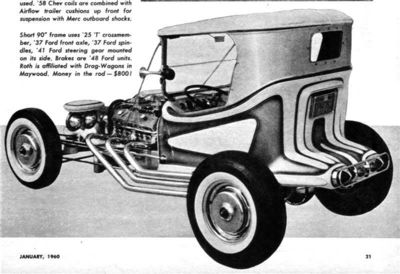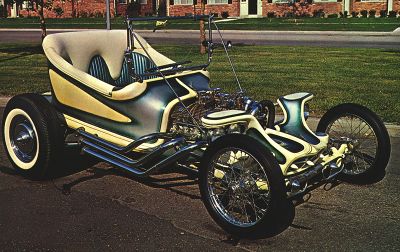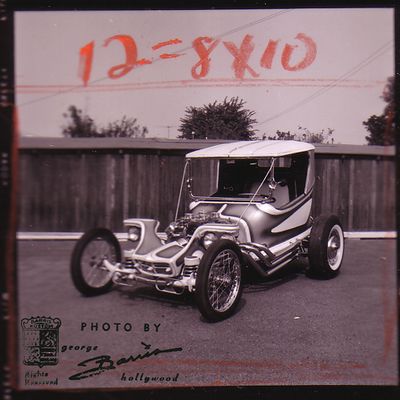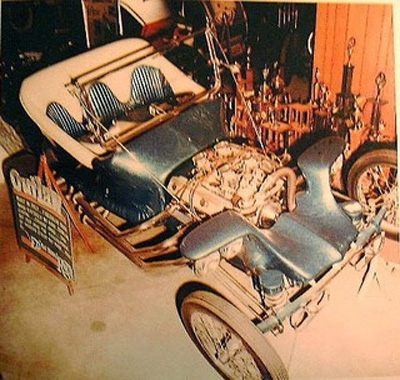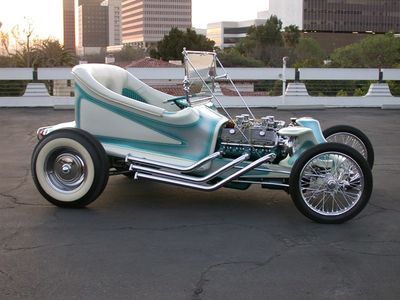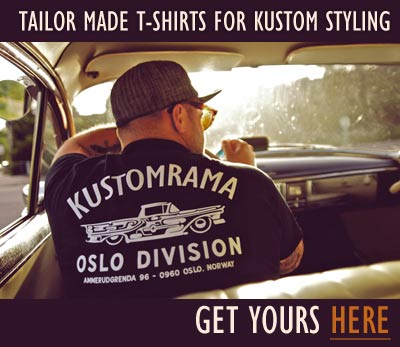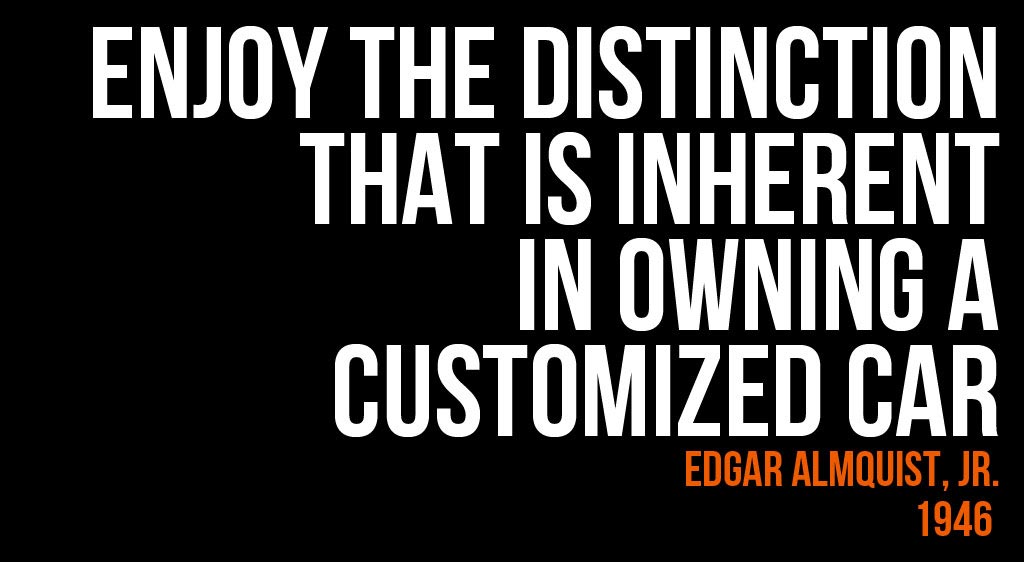Ed Roth's Outlaw
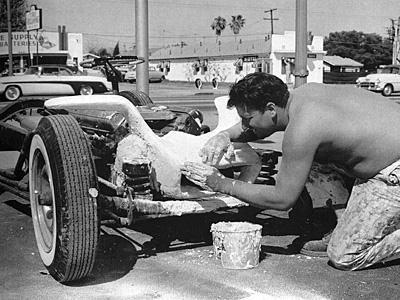







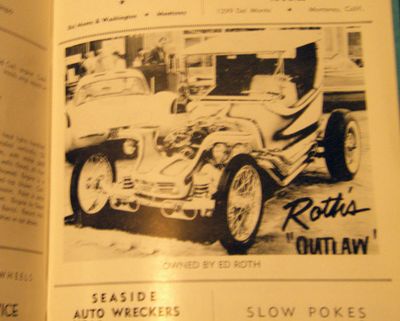

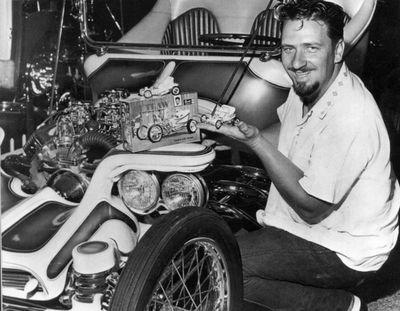
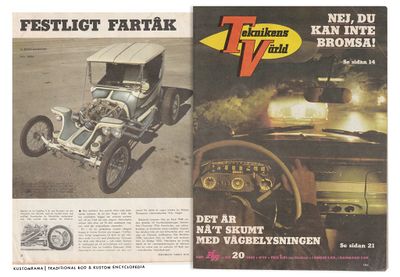

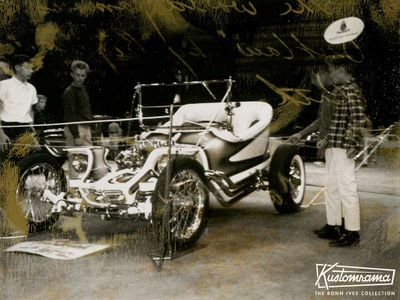



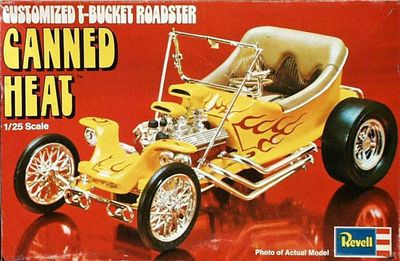
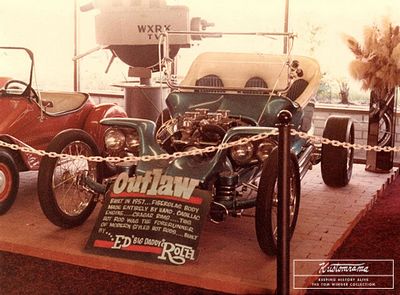
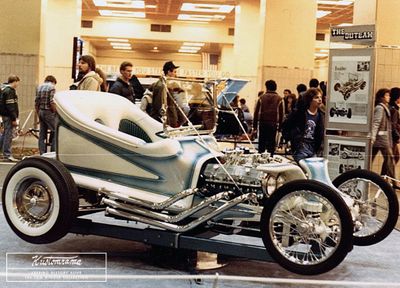
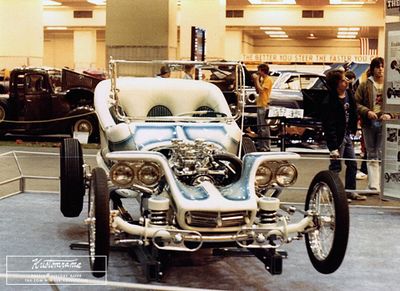
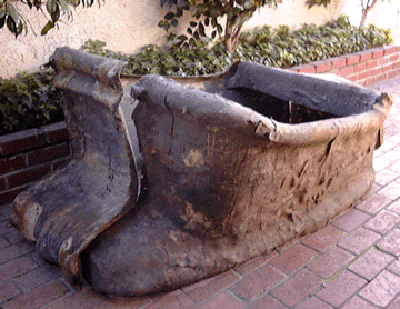
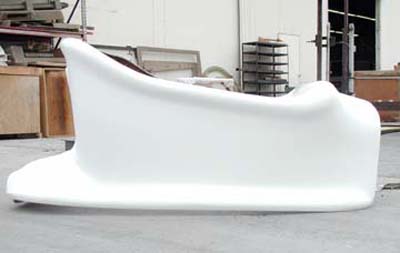
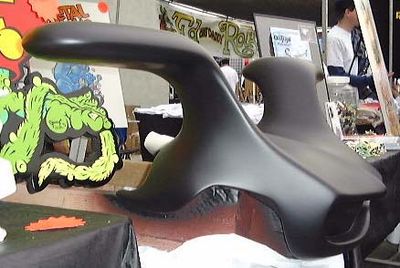
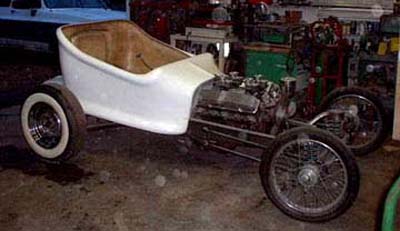
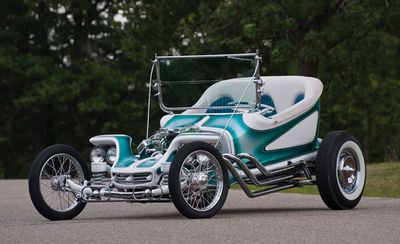

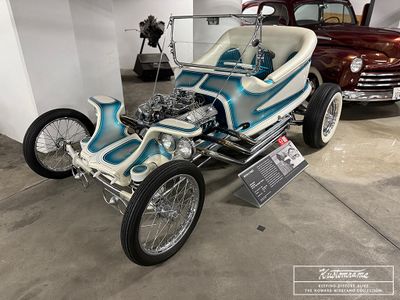
The Outlaw is a show rod built, owned and designed by Maywood Drag-Wagons member Ed "Big Daddy" Roth of Maywood, California. The Outlaw was Ed Roth's first experience with fiberglass, and it started out as a monster drawing on the back of a weirdo sweatshirt. Ed first got the idea for a fiberglass car after seeing a photo of Henry Ford swinging a sledgehammer on the deck lid of a 1941 Ford. The Ford featured a fiberglass deck lid, and according to the photo caption it wouldn't dent. This blew Roth away, and he made a mental note of this new material. Later on he was introduced to the mysterious material at the Huntington Beach Pier where he saw a surfer with a wooden surfboard. The surfboard was covered with a waterproof fiberglass covering. After that Ed read about a hot rodder named W. R. Shadoff in Life Magazine. Shadoff had built a Bonneville streamliner called the Shadoff Special out of fiberglass. The year was 1957, Ed was intrigued, and within days he was busy experimenting with fiberglass on his own in his new shop at 4616 Slauson Avenue in Maywood.[3]
The build was based on a basic 1929 Ford Model A frame fit with a 1925 Ford Model T crossmember. A 1950 Cadillac engine that Ed found on a junkyard was installed between the framerails. Ed had trouble finding anyone that could help him build a fiberglass body for his creation. He tried to make a body out of wood like they had done with the Shadoff Special, but it was too complicated, so Ed went to the local lumber yard and bought some casting plaster. The casting plaster was cheap and better than wood. Making the buck was no problem for Ed using the plaster. The buck was covered with the messy, goofy stuff known as fiberglass. According to the book Hot Rods by Ed "Big Daddy" Roth, a pair of pants lasted about a day when Ed was working with fiberglass. His shoes lasted about four days before he had to throw a coat of black paint on them. As no one knew the material at the time, Ed couldn't ask anyone for advice during the build, and he had to learn by trying. Things were done over and over agin until he finally got it right. When the glass cured he knocked the plaster out from the backside, and that became the female mold for the Outlaw.[4] The Outlaw is the only car for which Ed made a four-piece female mold that was held together with tool box latches.[5] Ed wanted to build and sell bodies to customers. In the book Hot Rods by Ed "Big Daddy" Roth, Ed claimed that he only made two bodies. The first body was sold to some unsuspecting dudes down the street, while the other one was used on the Outlaw. He only made one grille shell though. In the 1958 Fawcett How-To-Book # 427, Ed advertised the Outlaw body for sale at $229. It came with a firewall and instrument panel, primed for finish-painting. It came without the nose-piece, so that was up to the builder to create. Floorboards were not included as well. it is believed that Ed made less then ten bodies using the molds.[6] Ed Fuller, who worked for Roth at the time, once estimated that they made 12 to 15 Outlaw bodies in total.[5] The Outlaw mold sat on top of the Roth Studios for many years. At some point Roth moved, and he asked Jim "Jake" Jacobs if he wanted the mold as he was going to throw it out. After several years Jake ended up giving it to Robert Williams.[7] When the book Hot Rods by Ed "Big Daddy" Roth was published, the original female mold was still owned by Robert Williams, who also worked for Roth back in the days.[6]
As Ed had few tools when he built the Outlaw, he wired all the stuff he wanted welded together with bailing wire before he trailered the car down the street to Clarence Bell at the local trailer shop. Clarence welded the stuff together before Ed brought it back to the shop for final preparation work. Ed filed all the weld marks down by hand before the whole chassis was sent to the Chrome Nickel Plating in South Gate for chrome plating. The rear axle, drive shaft, and a 1939 Ford transmission were chromed as well. As the chrome budget went out of proportions during the build, Ed had to sell the Little Jewel to pay for the chrome on the Outlaw. Fritz Voigt, a local mechanic and sidekick of Mickey Thompson helped Ed with the build. Fritz rebuilt the Cadillac engine and fit it with four Stromberg 97s mounted on a Cragar manifold. The engine was also dressed up with Cal Custom finned valve covers, a chromed oil pan and a set of lengthy, sweeping zoomie headers. A front axle and spindles from a 1937 Ford V8 60 was installed up front along with a couple of front spring cups that housed cut down 1958 Chevrolet coil springs. The coils were combined with Airflow trailer cushions and Merc outboard shocks. The rest of the running gear, except for the Model A rear cross spring, came from a 1948 Ford. A 1941 Ford steering gear was mounted on the driver side. Front height was kept stock, while the rear was raised. The windshield frame came from a 1922 Dodge. Blue tinted safety glass was installed in the old Dodge frame. Taillights from a 1958 Chevrolet Bel-Air was fit with 1956 Chevrolet lenses before Ed installed them on the body. Quad headlights from a 1959 Rambler was installed up front. The headlights were mounted under the fenders in a special ring.The grille was made from a portion of a 1959 Chevrolet grille, and a stock DKW radiator was installed to cool down the enormous Cadillac engine. Nerf bars were designed and installed for protection.[8] Larry Watson of Watson's House of Style painted the car for Ed. The body was painted pearl white with fogged candy-green panels.[6]
Inside, Ed installed a 1958 Chevrolet Impala steering wheel and seven Stewart-Warner gauges. The Outlaw, originally named the Excaliber, made its debut at the Disneyland Car Club Day and Autocade Show September 5th 1959. The name Excaliber came from a sword Ed used as a gear shifter in the car. The sword was a Revolutionary War sword that came from his mother-in-law's family. As no one could pronounce the name for the car, he changed it to the Outlaw later on in 1960. At the Disneyland show the Excaliber was not judged because the interior was not finished. This version featured chromed Mercury wheels on all four corners, bullet caps, wide whites, and a tonneau cover over the missing interior. The Outlaw was originally fit with a gullwing top made of Naugahyde and aluminum over a wooden frame. Canning Hardware provided the aluminum for the gulling top. Later on in the 1960s, while trailering the car through Kansas, the top blew off. Ed never cared to turn around and look for the top as he knew it would have been destroyed anyway. The sensational Outlaw landed the cover of Car Craft January 1960, still featuring a tonneau cover over the interior and Mercury steel wheels on all four corners. Sometime after the Disneyland show Eddie Martinez upholstered the car in Naugahyde tuck-n-roll. The interior Martinez made was designed by Roth.[6] By July 1960 Roth was selling 8x10 glossies of the Outlaw in Car Craft Magazine. By then the front wheels had been replaced by spindle mounted wire wheels.[1] With the build completed, Ed took trophy after trophy with the car. He even claimed that it became unfair for him to compete with the car, so after he got aced out at the 1960 Oakland Roadster Show for using the new nylon lock nuts and not having cotter keys in the ball joints he quit competing with the car. He figured that his stuff was so wacky that he couldn't be judged anyway, so he traded for a T-shirt booth or went for appearance money instead.[6]
During the build, Ed had bought a 1940 Chevrolet that he could use to trailer the Outlaw around. Ed bought the car from Dick Cook. Dick had installed an Oldsmobile Tri-power in the car, and according to Ed it was the perfect tow car. The trailer was a "keep it simple" model built by Ron Aguirre's dad, Louie Aguirre. It had two tires, one axle and it was an open air model. The Chevy was later replaced by a series of Cadillac hearses that Ed could also sleep in while he was on the road.[6]
March 4-6, 1960, the Outlaw was shown at the Kustom Kar Kapades in Monterey, California.[9]
One day Revell Model Company called Ed and asked if they could make and sell a model kit of the Outlaw. Ed was thrilled and agreed on the offer. When Revell started making the model kit Henry Blankfort called Ed into his office and told him that his name needed a boost boost for the kits. Ed agreed and told Henry that he had always been called "Big Ed" at Bell High. Revell suggested that he should go with the "Dutch" movement and call himself something like "Spider" or "Roach". That didn't appeal to Ed. At about the same time there was a hippy movement in Los Angeles where guys let their beards grow and recite poetry at these coffee houses. The head stud muffins for these places were dubbed "Big Daddy". Henry decided to replace "Big Ed" with "Big Daddy". Ed figured that since he had 5 kids at home and since he was big, the name fit good. He agreed on the name, and both parts were happy. The kit was designed by Jim Keeler, who did the design work on several other Roth model kits later on.[6]
In 1961 Bob Larivee, Sr. made a deal with Ed to bring the Outlaw back to a bunch of shows. While he was on that circuit Bob made a deal with Ed to sell him the car. He told him that at the end of his tour that year he would like to buy the Outlaw. Ed agreed, and Bob paid him $3,250 for the Outlaw. Ed saw the deal as an opportunity to fund another build. He had already started on his next car the Beatnik Bandit by then. When the Beatnik Bandit was finished he already wanted to build the Mysterion, so he ended up selling the Beatnik Bandit as well to Bob. Both cars were big hits, and Bob toured Ed's cars for a while. Bob was really excited about the twin-engined Mysterion, so after a lot of soul searching he decided to trade the Outlaw and the Beatnik Bandit back to Ed for the Mysterion. Bob was happy with the deal at the time, but admitted later that the deal was probably the worst deal he ever made.[6]
After a rough life in show biz, being trailered all over the country, the Outlaw was painted in a green metalflake by Dirty Doug. In 1970 Ed sold the Outlaw to Jim Brucker for $50. Jim was a collector, and Ed figures that if he got it he would make sure it got into the right places. Ed was right, and the Outlaw was refurbished to it's original condition by Harrah's.[6]
Revell held the copyrights for the Outlaw model, while ed had the copyrights to the Roth name. He had also established proprietary rights on Outlaw. In the late 1960s Ed and Revell had a falling out, supposedly because of Ed's involvement with the Hell's Angels,[10] so the folks at Revell re-issued the Outlaw as "Canned Heat" in 1973 with no mention of Ed Roth.[11]
Contents
A Second Generation of Outlaw's
In 2002 Robert and Suzanne Williams, who owned the original mold for the Outlaw, offered the members of the Roth Estate in conjunction with, Rat Fink.Org and Kustom Art Studios to use Ed's original mold for a series of newly produced bodies that were going to be made, with proceeds from the sale going to the Roth Estate. As they didn't want to stress out the original mold, Jimmy C repaired the original mold, popped out a male buck from that before he pulled a female mold for the production. The cost of a body was $3,700.00, while the nose piece was sold for $1,260.00. All components were numbered and delivered with a certificate of authenticity. One of the first second generation body kits were sold to Mark Morarity who cloned the Outlaw. Another Outlaw clone was built by Fritz Schenck.[12]
Other Outlaw Bodied Cars
Clones
Mark Moriarity's Outlaw Clone
Fritz Schenck's Outlaw Clone
Magazine Features
Car Craft January 1960
Rodding & Re-styling March 1960
Car Craft July 1960
Custom Cars July 1960
Teknikens Värld Nr 20 1960
Car Speed and Style July 1961
Rodding and Restyling November 1961
Custom Rodder February 1962
Hot Rod DeLuxe 2
References
- ↑ 1.0 1.1 www.tbucketplans.com
- ↑ Carnut.com - Dave Stuckey Pics Page
- ↑ Rat Fink: The Art of Ed "Big Daddy" Roth
- ↑ Hot Rods by Ed "Big Daddy" Roth
- ↑ 5.0 5.1 American Custom Car
- ↑ 6.0 6.1 6.2 6.3 6.4 6.5 6.6 6.7 6.8 Cite error: Invalid
<ref>tag; no text was provided for refs namedherbed - ↑ Ratfink.org
- ↑ Car Craft January 1960
- ↑ The 1960 Kustom Kar Kapades Souvenir Program
- ↑ Showrods.com
- ↑ kaparich.homestead.com/rothkits4.html
- ↑ Cite error: Invalid
<ref>tag; no text was provided for refs namedrat fink
Did you enjoy this article?
Kustomrama is an encyclopedia dedicated to preserve, share and protect traditional hot rod and custom car history from all over the world.
- Help us keep history alive. For as little as 2.99 USD a month you can become a monthly supporter. Click here to learn more.
- Subscribe to our free newsletter and receive regular updates and stories from Kustomrama.
- Do you know someone who would enjoy this article? Click here to forward it.
Can you help us make this article better?
Please get in touch with us at mail@kustomrama.com if you have additional information or photos to share about Ed Roth's Outlaw.
This article was made possible by:
SunTec Auto Glass - Auto Glass Services on Vintage and Classic Cars
Finding a replacement windshield, back or side glass can be a difficult task when restoring your vintage or custom classic car. It doesn't have to be though now with auto glass specialist companies like www.suntecautoglass.com. They can source OEM or OEM-equivalent glass for older makes/models; which will ensure a proper fit every time. Check them out for more details!
Do you want to see your company here? Click here for more info about how you can advertise your business on Kustomrama.

